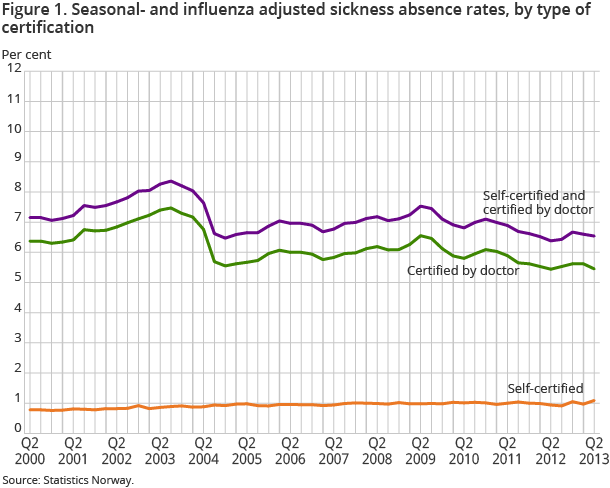Content
Published:
This is an archived release.
Stable sickness absence
Sickness absence adjusted for seasonal and influenza variations was 6.5 per cent in the 2nd quarter of 2013 – a decrease of 1.0 per cent from the 1st quarter of 2013.
| 2nd quarter 2013 | Per cent from previous quarter | |
|---|---|---|
| 1The sickness absence rates are shown to two decimal points. In other tables the rates are shown with one decimal point. More decimal points are used when calculating the rates of change in order to get more accurate figures. These will therefore differ slightly from the rates of change produced when using the published rounded figures. | ||
| Both sexes | ||
| Self-certified and certified by doctor | 6.54 | -1.0 |
| Self-certified | 1.09 | 11.3 |
| Certified by doctor | 5.45 | -3.1 |
| Males | ||
| Self-certified and certified by doctor | 5.05 | -1.5 |
| Self-certified | 0.92 | 6.5 |
| Certified by doctor | 4.14 | -3.1 |
| Females | ||
| Self-certified and certified by doctor | 8.39 | -0.5 |
| Self-certified | 1.29 | 16.0 |
| Certified by doctor | 7.10 | -3.0 |


Self-certified sickness absence increased by 11.3 per cent, while doctor-certified absence decreased by 3.1 per cent. Sickness absence decreased for both men and women – by 1.5 and 0.5 per cent respectively.
Since the 2nd quarter of 2001, when the agreement on an inclusive labour market was implemented, the seasonal and influenza-adjusted sickness absence has dropped by 9.5 per cent.
Statistics without seasonal and influenza adjustment
Since the following comments are based on data that is not adjusted for seasonal and influenza variations, we look at changes over the past year, from the 2nd quarter of 2012 to the 2nd quarter of 2013. Since these numbers are not adjusted for calendar effects, the position of Easter has an impact on sickness absence rates due to the number of contracted man-days. Last year, Easter was in the first quarter and this year it is in the second quarter. Sickness absence has been stable in this period, with an insignificant increase of 0.1 per cent.
Self-certified sickness absence increased by 14.1 per cent, while doctor-certified sickness absence decreased by 1.9 per cent.
Sickness absence almost unchanged for both genders
Sickness absence among women remained unchanged at 7.8 per cent, while sickness absence among men increased from 4.5 to 4.6 per cent.
Increase in the construction industries
Among the largest industries, sickness absence increased in construction and administrative and support service activities, with an increase of 4.8 per cent and 3.3 per cent respectively.
Small changes in sectors
Sickness absence in local government and public administration (including health enterprises) decreased by 0.6 per cent and 0.3 per cent respectively, while sickness absence in the private sector rose by 0.6 per cent.
Decrease in all age groups
Doctor-certified sickness absence decreased in all age groups. Among the largest age groups, persons age 25-29 years and 60-64 years had the largest decrease by 3.0 and 2.8 per cent respectively.
These results are based on data on sickness absence certified by a doctor as the survey on self-certified absence does not contain data on sickness absence by age.
Contact
-
Arbeidsmarked og lønn
E-mail: arbeidsmarked@ssb.no
-
Unn H. Høydahl
E-mail: unnh.hoydahl@ssb.no
tel.: (+47) 40 90 23 77
